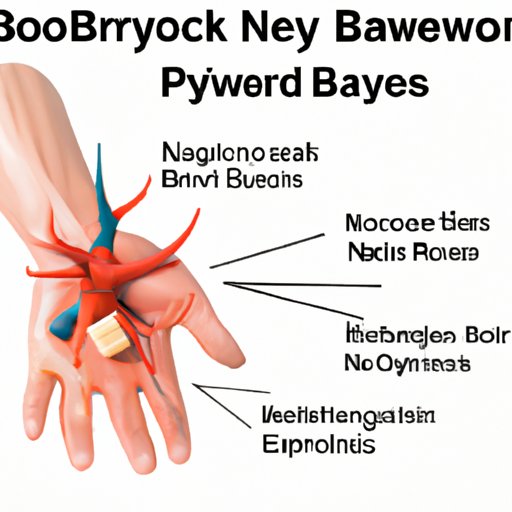Introduction
If you have ever experienced chronic or acute pain, you may have come across the term “nerve block”. Nerve blocks are commonly used to manage pain and decrease the need for opioid medication. In this comprehensive guide, we will discuss what nerve blocks are, how they work, and their benefits and risks.
Everything You Need to Know about Nerve Blocks: A Comprehensive Guide
Nerve blocks are a type of pain management technique that work by interrupting the transmission of pain signals from specific nerves to the brain. They are commonly used in people who have chronic pain conditions or for those who require surgery. The first nerve block was performed in the early 1900s and since then, advances in medical technology and research have led to the development of different types of nerve blocks.
Nerve blocks are used to treat pain in various parts of the body including the neck, shoulder, arms, back, hips, legs, and feet.
Nerve Blocks: How They Work and What to Expect During the Procedure
Nerve blocks are performed by injecting a solution (typically a local anesthetic or a combination of a local anesthetic and a steroid) into the affected nerve or group of nerves. The nerve block injection temporarily blocks the transmission of pain signals, leading to temporary pain relief. Depending on the type of nerve block and the area being treated, the patient may need to have multiple injections.
During the procedure, the doctor will use imaging techniques such as ultrasound or fluoroscopy to locate the nerve or nerves they are targeting. Once the nerve(s) is located, the doctor will inject the medication directly into the nerve or around it. Patients may feel a mild discomfort or pressure during the procedure, but pain is typically minimal.
Pain relief from the nerve block injection typically lasts from a few hours to several months, depending on the type of medication used.
Types of Nerve Blocks and Their Uses: A Breakdown
There are different types of nerve blocks used to treat different types of pain. Here are some of the most common:
- Somatic nerve blocks: used to treat pain in the back, arms and legs
- Sympathetic nerve blocks: used to treat pain associated with conditions such as complex regional pain syndrome and shingles
- Peripheral nerve blocks: used to treat pain in specific areas of the body such as the face, neck, or shoulder
- Epidural nerve blocks: used to treat pain in the lower back or legs
Overall, nerve blocks are used to manage nociceptive pain (acute) and neuropathic (chronic) pain.
The Benefits and Risks of Getting a Nerve Block
Like any medical procedure, there are benefits and risks associated with getting a nerve block. Some of the benefits include:
- Effective pain management without the need for opioid medication
- Long-term pain relief in some cases
- Improvement in mobility and function
Some potential risks and side effects to be aware of include:
- Temporary numbness or tingling
- Localized swelling or infection at the injection site
- Bleeding
- Temporary drop in blood pressure
- Seizures in rare cases

How Nerve Blocks are Used in Pain Management
Nerve blocks can be a helpful addition to a pain management plan. They can help manage acute pain, as well as chronic pain conditions such as sciatica, neuropathy and fibromyalgia. Nerve blocks can also be used to treat pain following surgery or injury.
Sometimes, nerve blocks are used diagnostically to help determine the cause of a patient’s pain. For example, if a nerve block provides temporary pain relief, it can help confirm the origin point of the pain, which can help guide future treatment options.
A Patient’s Experience with Nerve Block Injections
As a patient who has experienced chronic pain, John decided to try nerve block injections to manage his condition. He describes the experience as “not much worse than getting a shot at the doctor’s office.” John noted that the injection site was numb for a few hours after the procedure, and that he did feel a bit sore in the following days, but overall he reported significant pain reduction. John’s nerve block lasted for about four months before he started to notice the pain returning.
Alternative Treatment Options to Nerve Blocks for Chronic Pain Management
While nerve blocks can be a helpful addition to a pain management plan, they are not the only option. Other alternative treatment options to consider include:
- Physical therapy
- Chiropractic care
- Acupuncture
- Medications (such as non-steroidal anti-inflammatory drugs)
- Non-opioid pain relievers (such as anti-epileptic or antidepressant drugs)
Consult with your doctor to determine what alternative treatment options could be beneficial for you.
Conclusion
Nerve blocks can be a helpful solution for pain management that addresses the underlying cause of the pain and aims to provide long-term relief without the need for opioid medication. Knowing the benefits and risks can help you make an informed decision and decide if nerve blocks are the right treatment option for you. As always, consult with your doctor to determine the best course of treatment for your individual needs.
